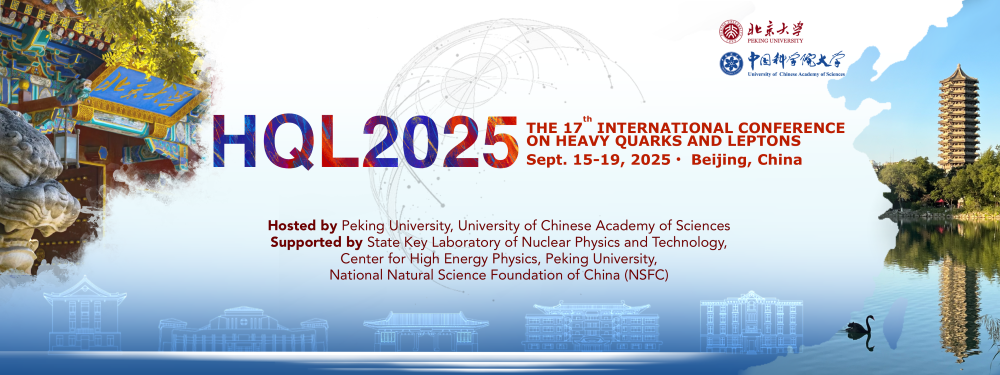The Fermilab Muon g-2 experiment has measured the muon's anomalous magnetic moment (a_μ) with a precision of 139 ppb, based on Run-456 dataset collected from 2020 to 2023. The new result confirms the earlier Run1 and Run2-3 measurements while significantly reducing overall uncertainty through improved systematic controls and using over 2.5 times more positron statistics than before. The...
The general 2HDM allows for off-diagonal flavour violating couplings in the quark sector which are strongly constrained by experiments in traditional 2HDMs. We study how the allowed parameter space of the general 2HDM changes once interactions between 1-3 and 2-3 quark generations are included, generating new interference terms in the one loop diagrams relevant for meson mixing constraints and...
Search for the charmless baryonic decay $B^+\to\bar{\Lambda}p\bar{p}p$ is performed using proton-proton collision data recorded by the LHCb experiment, corresponding to an integrated luminosity of 5.4$\text{fb}^{-1}$. The branching fraction is measured to be $\mathcal{B}(B^+\to\bar{\Lambda}p\bar{p}p) = (2.08 \pm 0.34 \pm 0.10 \pm 0.26) \times 10^{-7}$, where the first uncertainty is...
We present a novel method for measuring $|V_{cb}|$ at general-purpose experiments at the LHC using an advanced boosted-jet tagger to identify "bc signatures". When combined with the conventional small-radius jet approach, this method achieves a ~30% improvement in $|V_{cb}|$ precision under HL-LHC projections, providing valuable insights into the $V_{cb}$ puzzle. By leveraging Lorentz-boosted...
Semi-leptonic decays offer an ideal place to deeply understand hadronic transitions in the nonperturbative region of QCD and explore the weak and strong interactions in the charm sector. Combining with experimental data, the CKM matrix element can be extracted, and it helps to test unitarity of CKM matrix and searching for new physics beyond SM. In this talk, the full lattice QCD calculations...
We present an web-based platform for Amplitude Analysis, designed to facilitate the exploration of multi-body decays. In such analyses, the large number of possible decay chains often presents a significant challenge in constructing amplitudes.
Our tool offers a user-friendly graphical interface (GUI) that enables efficient sorting, filtering, filling, and validation of decay chains....
We present the first calculation of charmed baryon decay constants using 2+1 flavor gauge ensembles with lattice spacings ranging from 0.05 to 0.1 fm and pion masses between 136 and 310 MeV. Under SU(3) flavor symmetry, we construct the charmed baryon interpolating operators and compute the corresponding hadronic matrix elements to extract the bare decay constants for each ensemble. The...
A complete set of optimized CP-averaged angular observables in the rare flavor-changing neutral-current decay $B^0 \rightarrow K^*(892)^0 \mu^+ \mu^-$, with $K^*(892)^0 \rightarrow K^+ \pi^-$, is measured using the full Run 2 dataset of proton-proton collisions at $\sqrt{s} = 13 \ \rm{TeV}$ collected by the CMS detector, corresponding to an integrated luminosity of 140 $\rm{fb}^{-1}$. The...
The Compressed Baryonic Matter (CBM) experiment at FAIR, with its unprecedented rate capabilities and precision vertexing, offers a unique opportunity to advance charm physics through its dedicated proton beam program. A central objective of this program is to investigate the production and propagation of charm hadrons in cold nuclear matter. Such studies will provide indispensable baseline...
Three enigmatic structures, X(6600), X(6900), and X(7100), have emerged from the J/ψJ/ψ (J/ψ → μ+μ−) spectrum as candidate all-charm tetraquarks, a rare and exotic form of matter. Using 315 fb^{−1} of proton-proton collisions data recorded by the CMS detector, yielding 3.6 times more J/ψJ/ψ pairs than previous studies, one can achieve a sharper view of these states, with significantly improved...
In the study of the $J/\psi$$J/\psi$ invariant mass spectrum, the CMS collaboration has observed three distinct structural features, labeled as X(6600), X(6900), and X(7100). In-depth analysis of the experimental data suggests that a theoretical model incorporating the quantum interference effects of these three resonance states best describes the observed mass spectrum distribution...
The traditional quark model accounts for the existence of baryons, such as protons and neutrons, which consist of three quarks, as well as mesons, composed of a quark-antiquark pair. Only recently has substantial evidence started to accumulate for exotic states composed of four or five quarks and antiquarks. The exact nature of their internal structure remains uncertain. This paper reports the...
The study of the charmed baryons is crucial for investigating the strong and weak interactions in the Standard Model and for gaining insights into the internal structure of baryons. In an $e^+e^-$ experiment the lightest charmed baryon, $\Lambda_c^+$, can be produced in pairs through the single photon annihilation process. This process can be described by two complex electromagnetic form...
Charmonium state decays provide critical insights into Quantum Chromodynamics (QCD) dynamics. Early theoretical frameworks interpreted two-meson charmonium decays as perturbative QCD (pQCD) processes following helicity selection rules (HSR). BESIII observations of comparable chic1→phi + phi and chic0/chic2→phi + phi branching fractions demonstrate explicit HSR violations, compelling...
The modification of quarkonium state production in the deconfined QCD medium in nuclear collisions does not solely originate from the medium dissociation but rather is a collection of effects from initial to final states. Excited charmonium production in pPb collision can be thought of as a controlled environment to understand these effects. In particular, the production of the $chi_c$ mesons,...
We present a comprehensive partial wave analysis of $\psi(3686) \to \gamma\chi_{cJ} \to \gamma\Lambda\bar{\Lambda}$ decays ($J=0,1,2$) using $2712.4 \pm 14.3$ million $\psi(3686)$ events collected by the BESIII experiment. This analysis provides the first determination of the helicity amplitude ratio for $\chi_{c2} \to \Lambda\bar{\Lambda}$ decay, yielding $R_{\chi_{c2}} = 0.575 \pm 0.048 \pm...
By analyzing $e^+e^-$ collision data taken at center-of-mass energies $\sqrt{s}$ between 4.600 and 4.699 GeV with the BESIII detector at the BEPCII collider, corresponding to an integrated luminosity of $\rm 4.5~fb^{-1}$, we study the hadronic decays $\Lambda_{c}^{+} \rightarrow \Sigma^{+} \eta$ and $\Lambda_{c}^{+} \rightarrow \Sigma^{+} \eta^{\prime}$ using the single-tag method. The...

